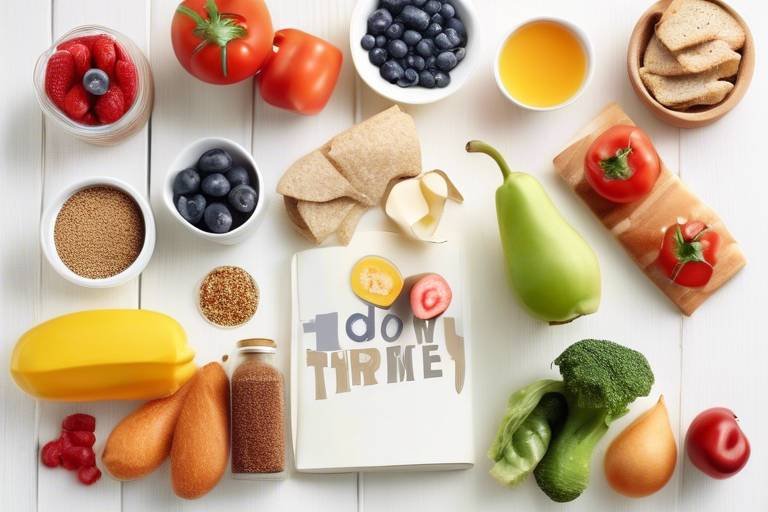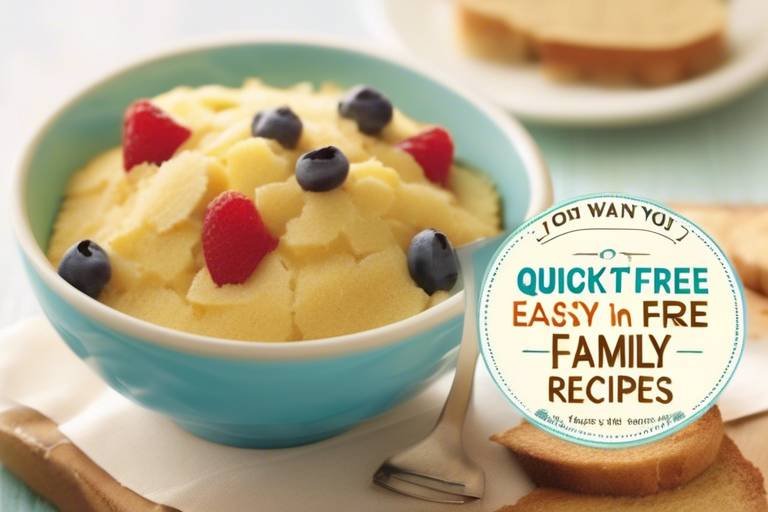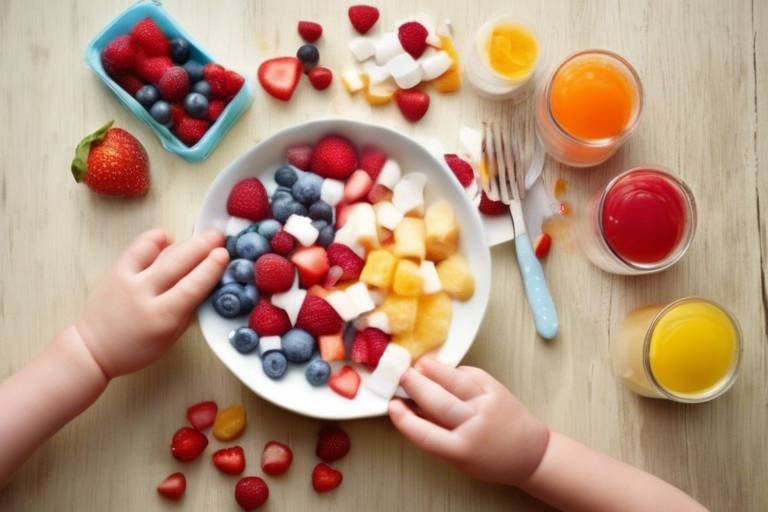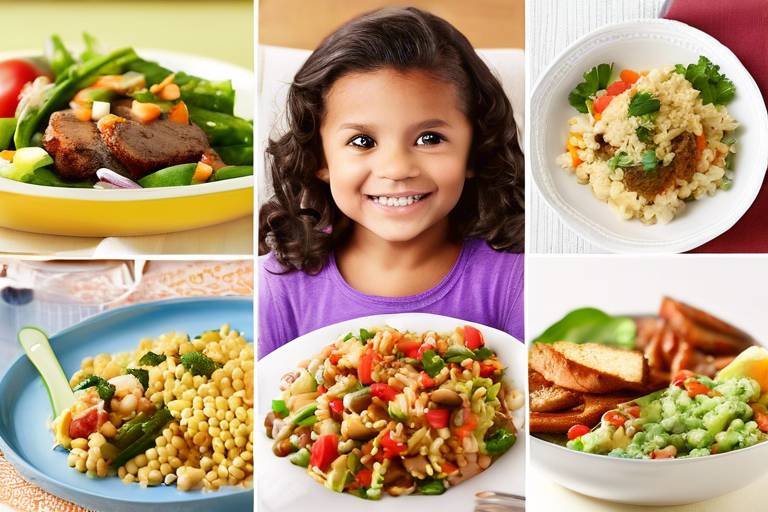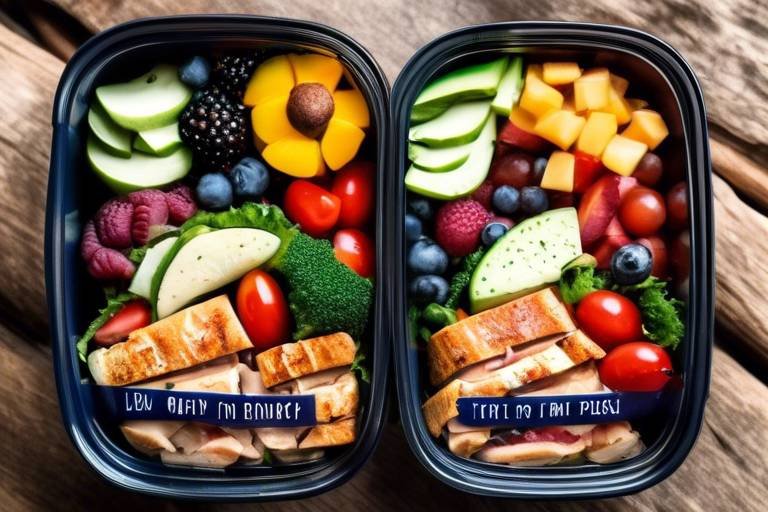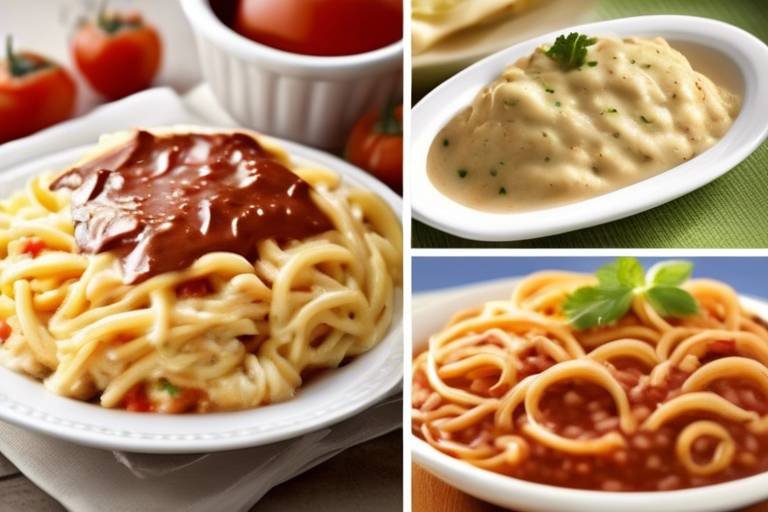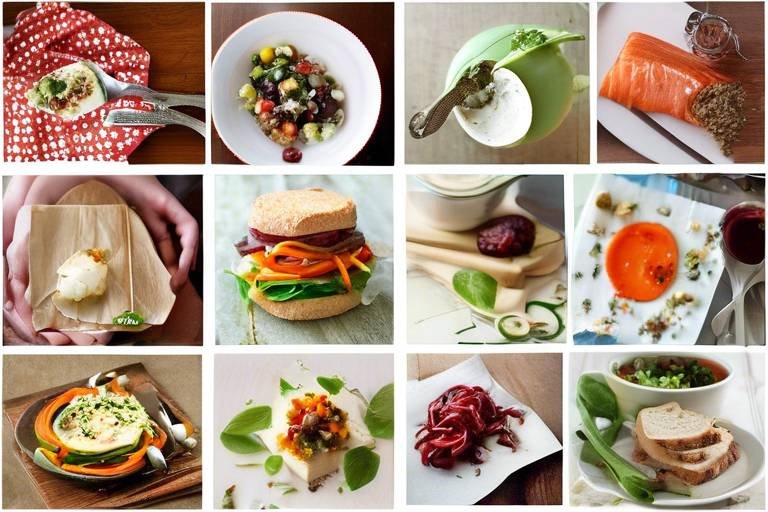Weekly Meal Plans for Kids With Food Allergies
Creating meal plans for children with food allergies can feel like navigating a minefield. With so many potential allergens lurking in common foods, it’s crucial to approach meal planning with both caution and creativity. The goal is to ensure that your little ones enjoy nutritious and safe meals that not only satisfy their taste buds but also cater to their specific dietary restrictions. In this article, we will dive deep into the world of meal planning for kids with food allergies, offering practical tips, delicious recipes, and everything you need to make mealtime a breeze.
Food allergies in children are more common than you might think, affecting millions of kids worldwide. Common allergens include peanuts, tree nuts, dairy, eggs, soy, wheat, fish, and shellfish. Symptoms can range from mild reactions, like hives and stomach aches, to severe anaphylactic responses that require immediate medical attention. This makes it vital for parents to identify specific food sensitivities to create effective meal plans. Knowing what to avoid is just as important as knowing what to include. By understanding the specific allergens your child reacts to, you can craft a meal plan that keeps them safe while still being delicious.
Designing a balanced meal plan is essential for ensuring that children receive all the nutrients they need for optimal growth and development. A well-rounded plan should include a variety of foods, making sure to incorporate fruits, vegetables, proteins, and healthy fats while steering clear of allergens. Think of your meal plan as a colorful palette – the more colors (or foods) you can include, the more nutrients your child will receive. For example, instead of just focusing on one type of protein, you might rotate between chicken, lentils, and quinoa, ensuring that your child gets a range of amino acids and other vital nutrients.
Whole foods are the cornerstone of any healthy meal plan, especially for kids with allergies. These foods – such as fresh fruits, vegetables, whole grains, and lean proteins – are not only packed with essential nutrients but are often free from common allergens. For instance, instead of processed snacks that may contain hidden allergens, consider offering sliced apples with sunflower seed butter or carrot sticks with hummus. Whole foods are like nature's multivitamins, providing your child with the vitamins and minerals they need without the risk of allergic reactions.
When it comes to packaged foods, reading labels is an absolute must. Ingredients can hide in plain sight, and allergens can be present in unexpected places. Look for labels that clearly state “free from” or “allergen-friendly” to make your shopping experience smoother. Additionally, familiarize yourself with common terms that may indicate the presence of allergens. For example, terms like “casein” can indicate dairy, while “hydrolyzed vegetable protein” can sometimes contain soy. A keen eye can save you from potential mishaps and keep your child safe.
Meal prepping can be a game changer for busy parents. By dedicating a few hours each week to prepare meals in advance, you can ensure that allergen-free options are always on hand. Start by batch-cooking grains or proteins that can be used in various meals throughout the week. For instance, roasted chicken can be transformed into salads, wraps, or stir-fry. Additionally, consider investing in quality containers to store prepped meals, making it easy to grab and go. This approach not only saves time but also reduces the likelihood of last-minute decisions that could lead to allergen exposure.
Kids love snacks, and with a little creativity, you can whip up delicious and safe options that satisfy their cravings. Think outside the box: instead of traditional cookies that might contain allergens, try making energy bites with oats, sunflower seeds, and honey. Or, how about yogurt parfaits using dairy-free yogurt topped with fresh fruit and gluten-free granola? These snacks not only keep your child fueled between meals but also make them feel included during snack time with their friends. Remember, snacks can be both fun and healthy!
Now that we’ve covered the essentials of meal planning, let’s dive into some allergy-friendly recipes that are sure to please your little ones. These recipes are designed to be simple, nutritious, and free from common allergens, making them perfect for your weekly meal plans.
Starting the day with a nutritious breakfast is crucial. Here are some creative ideas:
- Banana Oatmeal Pancakes: Made with mashed bananas, oats, and almond milk (or any non-dairy milk), these pancakes are fluffy and delicious.
- Chia Seed Pudding: Combine chia seeds with coconut milk and let it sit overnight. In the morning, top it with fresh berries for a refreshing start.
For dinner, think about meals that everyone can enjoy together:
- Quinoa Stir-Fry: Packed with colorful veggies and your choice of protein, this dish is both filling and allergen-friendly.
- Stuffed Bell Peppers: Fill bell peppers with a mixture of brown rice, beans, and spices for a hearty meal that’s sure to impress.
1. What are the most common food allergies in children? The most common food allergies include peanuts, tree nuts, dairy, eggs, soy, wheat, fish, and shellfish.
2. How can I tell if my child has a food allergy? Symptoms can vary widely but may include hives, stomach pain, vomiting, or even anaphylaxis. Consult a healthcare provider for proper testing.
3. Are there safe alternatives to common allergens? Yes! There are many allergen-free products available, such as almond milk instead of cow's milk and chickpea flour instead of wheat flour.

Understanding Food Allergies
Food allergies are a significant concern for many families, especially when it comes to children. Imagine your little one excitedly diving into a plate of their favorite food, only to experience a sudden and frightening reaction. This is the reality for many parents, making it crucial to understand what food allergies are, their symptoms, and how to manage them effectively.
At its core, a food allergy is an immune response that occurs when the body mistakenly identifies a harmless food protein as a threat. This can lead to a range of symptoms that may vary from mild to severe. Common allergens include:
- Peanuts
- Tree nuts
- Milk
- Eggs
- Wheat
- Soy
- Fish
- Shellfish
Recognizing the signs of a food allergy is essential for prompt action. Symptoms can manifest in various ways, including:
- Skin reactions: Hives, rashes, or swelling
- Gastrointestinal issues: Nausea, vomiting, or diarrhea
- Respiratory problems: Wheezing, nasal congestion, or difficulty breathing
- Anaphylaxis: A severe, life-threatening reaction that requires immediate medical attention
Identifying specific food sensitivities is a critical step in effective meal planning. Parents should work closely with healthcare professionals to conduct allergy testing and keep a detailed food diary. This practice helps pinpoint exact allergens, making it easier to eliminate them from your child’s diet. The goal is to create a safe and nutritious meal plan that accommodates your child's unique needs while ensuring they receive all the essential nutrients for healthy growth and development.
So, why is it so important to understand food allergies? Well, knowledge is power! The more you know about your child's allergies, the better equipped you'll be to navigate mealtime challenges. This understanding also fosters a supportive environment for your child, helping them feel safe and included during meals, whether at home or in social settings.
In summary, food allergies can be daunting, but with the right information and proactive planning, you can ensure your child enjoys a varied and balanced diet. Stay tuned as we dive deeper into creating balanced meal plans and incorporating allergy-friendly recipes!

Creating a Balanced Meal Plan
Creating a balanced meal plan for children with food allergies can feel like navigating a minefield, but it doesn’t have to be overwhelming. The key is to focus on diversity and nutrition while steering clear of allergens. A balanced meal plan should include a variety of food groups that provide essential nutrients needed for growth and development. Think of it as crafting a colorful plate, where each color represents a different nutrient that your child needs. By incorporating fruits, vegetables, proteins, and grains, you can ensure that your child receives a well-rounded diet.
When planning meals, aim to include the following components:
- Fruits and Vegetables: These should make up a significant portion of your child's meals. They are packed with vitamins, minerals, and fiber. Try to include a rainbow of colors to maximize nutrient intake.
- Proteins: Lean meats, fish, eggs, and plant-based proteins like beans and lentils are excellent choices. They are essential for muscle growth and repair.
- Grains: Whole grains such as brown rice, quinoa, and oats provide energy and are often more nutritious than their refined counterparts.
- Dairy or Alternatives: If your child is not allergic to dairy, include options like yogurt and cheese. For those with dairy allergies, consider fortified plant-based alternatives.
It's also crucial to consider meal timing and portion sizes. Children have different energy needs throughout the day, so plan for three main meals and two snacks to keep their energy levels stable. A good rule of thumb is to fill half of their plate with fruits and vegetables, one quarter with protein, and the remaining quarter with grains. This method not only ensures that they are getting a balanced diet but also helps them develop healthy eating habits.
Another important aspect of creating a balanced meal plan is to be mindful of food preparation methods. Opt for baking, steaming, or grilling instead of frying to keep meals healthy. Additionally, be cautious with sauces and dressings, as they can often contain hidden allergens. Always make your own when possible, so you know exactly what goes into your child's meals.
Lastly, involve your child in the meal planning process. This can be a fun way to teach them about nutrition and help them feel more invested in their food choices. Ask them what fruits and vegetables they enjoy, or let them pick out a new grain to try. By making meal planning a collaborative effort, you’ll not only ease the stress of cooking but also encourage healthy eating habits that can last a lifetime.
1. How can I ensure my child is getting enough nutrients if they have multiple food allergies?
Consulting with a dietitian can be incredibly helpful. They can provide tailored advice and suggest alternative foods that can fill nutritional gaps.
2. What are some common allergens to watch out for?
Common allergens include peanuts, tree nuts, dairy, eggs, wheat, soy, fish, and shellfish. Always read labels carefully and consider cross-contamination.
3. How can I introduce new foods to my child who is picky?
Start by introducing small amounts of new foods alongside familiar favorites. Make it fun by involving them in the cooking process or creating themed meals.
4. Are there any resources for allergy-friendly recipes?
Yes! There are numerous websites and cookbooks dedicated to allergy-friendly cooking. Look for those that cater specifically to your child's allergies.

Incorporating Whole Foods
When it comes to meal planning for kids with food allergies, is a game-changer. Whole foods are those that are minimally processed and free from artificial ingredients, making them a fantastic choice for ensuring your child gets the nutrients they need without the risk of allergens. Think about it: when you fill your pantry with fruits, vegetables, whole grains, and lean proteins, you’re not just avoiding allergens; you’re also providing a colorful array of vitamins and minerals that support your child’s growth and development.
Imagine a plate filled with vibrant fruits and veggies. Not only are they visually appealing, but they also come packed with fiber, antioxidants, and essential nutrients. For example, leafy greens like spinach and kale are rich in iron and calcium, while berries offer a sweet treat loaded with vitamin C. By focusing on whole foods, you can create meals that are both nutritious and delicious, allowing your child to enjoy a variety of flavors and textures.
Whole grains, such as quinoa, brown rice, and oats, are another excellent addition to your meal plan. They provide sustained energy and are often free from common allergens like gluten (in the case of quinoa and rice). Incorporating these grains into meals can be as simple as swapping out white rice for brown rice or adding quinoa to a salad. Not only do they add a nutty flavor, but they also enhance the meal's nutritional profile.
Furthermore, using whole foods means you can control what goes into your meals. For instance, when you prepare homemade snacks like energy bites or smoothies, you can ensure that every ingredient is safe for your child. In contrast, many packaged snacks contain hidden allergens or additives that may not be suitable. By choosing whole foods, you can create wholesome snacks that are both satisfying and safe.
Ultimately, incorporating whole foods into your child’s diet isn’t just about avoiding allergens; it’s about embracing a lifestyle that prioritizes health and well-being. By making small changes, like swapping processed snacks for fresh fruit or opting for whole grain bread instead of white, you can set your child up for a lifetime of healthy eating habits. It’s all about finding balance and making informed choices that cater to their specific dietary needs.
Q: What are whole foods?
A: Whole foods are natural foods that are minimally processed and free from artificial ingredients, such as fruits, vegetables, whole grains, and lean proteins.
Q: How can I ensure my child gets enough nutrients while avoiding allergens?
A: Focus on incorporating a variety of whole foods into your child's diet, ensuring they receive a balanced intake of vitamins and minerals from different sources.
Q: What are some easy whole food snack ideas for kids?
A: Some easy whole food snacks include fresh fruit, vegetable sticks with hummus, homemade granola bars, and yogurt with berries.

Reading Labels Effectively
When it comes to feeding children with food allergies, can be a game-changer. It’s essential to understand that food packaging can be a maze of information, and navigating it might feel overwhelming at first. However, with a little practice, you’ll become a pro at spotting potential allergens and making safe choices for your little ones.
First and foremost, always look for the allergen statement, typically found at the bottom of the ingredient list. This statement will highlight common allergens such as peanuts, tree nuts, milk, eggs, soy, wheat, fish, and shellfish. For example, if you see a label that says, “Contains: Milk, Wheat,” you’ll know to steer clear of that product. It’s like having a secret decoder ring that reveals the hidden dangers lurking in your pantry!
Next, familiarize yourself with the ingredients list. Ingredients are listed in descending order by weight, meaning the first few items on the list make up the bulk of the product. If you notice any unfamiliar terms, don’t hesitate to do a quick online search. Some ingredients may be derived from allergens, and knowing their origins can help you avoid any surprises. For instance, casein is a milk protein that could be a hidden threat for lactose-intolerant kids.
It’s also important to be aware of cross-contamination, which can occur during manufacturing. Many products may not contain allergens themselves but could be processed in facilities that handle them. Look for terms like “may contain traces of” or “produced in a facility that processes.” This information can help you make informed decisions. If you see a label that says, “May contain peanuts,” it’s better to opt for a different product to ensure your child stays safe.
Here’s a tip: create a little cheat sheet of common allergens and their alternative names. This way, when you’re at the store, you can quickly reference it while scanning labels. You might be surprised by how many different names an allergen can have!
Lastly, don’t forget to check for any certifications on the packaging. Look for labels like “gluten-free,” “dairy-free,” or “nut-free,” which can provide an additional layer of assurance. These certifications often indicate that the product has undergone testing and meets specific safety standards. It’s like having a trusted friend vouch for the food you’re buying!
In summary, mastering the art of reading food labels is crucial for parents of children with food allergies. With a keen eye and a little knowledge, you can confidently navigate the grocery store aisles, ensuring that the meals you prepare are not only delicious but also safe for your kids. Remember, your child’s health is your top priority, and being informed is the first step toward a worry-free mealtime experience!
- What should I do if my child has an allergic reaction? - Always consult a healthcare professional immediately. If your child has a known allergy, keep an epinephrine auto-injector on hand.
- Are all allergens listed on food labels? - Not always. While major allergens must be declared, some may not be explicitly listed, so always read carefully.
- How can I ensure my child's meals are safe? - Always read labels, avoid cross-contamination, and consider meal prepping at home to control ingredients.

Meal Prep Tips
Meal prepping can feel like a daunting task, especially when you're juggling the dietary needs of a child with food allergies. However, with some thoughtful planning and a sprinkle of creativity, you can transform meal preparation into a fun and efficient routine that ensures your little one enjoys safe and nutritious meals. Start by dedicating a specific day of the week for meal prep. This not only helps you stay organized but also allows you to set aside time to focus solely on creating delicious meals. Think of it as a mini cooking adventure where you can explore new recipes and flavors!
One of the first steps in effective meal prep is to create a weekly menu. This menu should include breakfast, lunch, dinner, and snacks, tailored to your child’s taste preferences and dietary restrictions. By planning ahead, you can avoid the last-minute scramble for allergen-free options. Consider using a simple table to outline your meal plan:
| Day | Breakfast | Lunch | Dinner | Snacks |
|---|---|---|---|---|
| Monday | Oatmeal with berries | Quinoa salad | Grilled chicken and veggies | Apple slices with almond butter |
| Tuesday | Smoothie bowl | Rice wraps | Beef stir-fry with broccoli | Carrot sticks with hummus |
Next, consider batch cooking. This means preparing larger quantities of meals that can be divided into portions and stored for later use. For instance, making a big pot of soup or stew can provide several meals throughout the week. Just make sure to store the food in airtight containers, labeling them with the date and contents. This way, you’ll know exactly what you have on hand and can easily grab a meal when you’re short on time.
Another tip is to involve your child in the meal prep process. Kids love to help out in the kitchen, and by allowing them to participate, you can teach them about healthy eating and food safety. Simple tasks like washing vegetables, mixing ingredients, or even choosing which snacks to prepare can make them feel included and excited about their meals. Plus, it’s a great way to bond and create lasting memories!
Lastly, always keep a well-stocked pantry with allergen-free staples. Items like rice, beans, oats, and various fruits and vegetables can serve as the foundation for countless meals. When you have these essentials on hand, whipping up a quick meal becomes a breeze, even on the busiest of days. Remember, meal prep doesn’t have to be perfect; it just needs to be practical and enjoyable. Keep experimenting with new recipes and flavors, and soon enough, you’ll find a rhythm that works for you and your family!
- What are some common food allergies in children? Common allergens include milk, eggs, peanuts, tree nuts, soy, wheat, fish, and shellfish.
- How can I ensure my child is getting enough nutrients on a restricted diet? Focus on incorporating a variety of whole foods, including fruits, vegetables, proteins, and grains, while avoiding allergens.
- What should I do if my child has a severe allergic reaction? Always have an emergency plan in place, including having an epinephrine auto-injector available and knowing how to use it.

Snacks and Treats
When it comes to kids, snacks and treats are like the cherry on top of a sundae—they can make or break their day! For children with food allergies, finding safe and delicious options can feel like searching for a needle in a haystack. But fear not! With a little creativity and some smart planning, you can whip up snacks that not only cater to their dietary needs but also make snack time a fun and enjoyable experience.
First things first, let's talk about what makes a snack truly appealing. Kids love snacks that are colorful, crunchy, and fun to eat. Think about incorporating a variety of textures and flavors to keep things exciting. For instance, you can create a vibrant fruit platter with allergy-friendly fruits like apples, bananas, and berries. These fruits are not only safe for most allergy sufferers but also packed with vitamins and minerals that are essential for growth.
Another fantastic option is to make homemade energy bites. These little power-packed balls can be customized to suit your child's specific allergies. You can use ingredients like oats (gluten-free if needed), nut butter (or seed butter for nut allergies), honey, and add-ins like dried fruits or seeds. Just mix everything together, roll them into bite-sized balls, and you’ve got a nutritious snack that’s easy to grab on the go!
For those days when you want to indulge a bit, consider making allergy-friendly cookies. You can use alternatives like coconut flour or chickpea flour instead of wheat flour, and sweeten them with maple syrup or agave nectar. Chocolate chips made from dairy-free chocolate can be a delightful addition. Kids will love helping in the kitchen, and you’ll be amazed at how quickly these treats disappear!
Don’t forget about savory snacks! Popcorn is a great option—just make sure it’s popped in an allergen-free oil. Spice it up with some nutritional yeast for a cheesy flavor without the dairy. Veggie sticks paired with hummus or guacamole can also be a hit. They’re crunchy, satisfying, and loaded with nutrients. Plus, they give kids a chance to explore different vegetables and flavors.
Here’s a quick overview of some snack ideas to keep in your back pocket:
| Snack | Allergen-Free Ingredients |
|---|---|
| Fruit Platter | Apples, bananas, berries |
| Homemade Energy Bites | Oats, nut/seed butter, honey, dried fruits |
| Allergy-Friendly Cookies | Coconut flour, dairy-free chocolate chips |
| Popcorn | Allergen-free oil, nutritional yeast |
| Veggie Sticks with Hummus | Carrots, cucumbers, bell peppers, hummus |
Incorporating these snacks into your weekly meal plan can ensure that your child has safe, tasty options that keep their energy levels up and their spirits high. It’s all about making snack time an adventure rather than a chore. So, roll up your sleeves and get creative! Your kids will thank you for it.
Q: What are some common allergens to watch out for in snacks?
A: Common allergens include peanuts, tree nuts, dairy, eggs, wheat, soy, fish, and shellfish. Always check labels and be aware of cross-contamination.
Q: How can I ensure snacks are safe for my child?
A: Always read food labels carefully, consider making snacks from scratch, and consult with your child’s allergist for specific guidelines.
Q: Are there any store-bought snacks that are safe for kids with allergies?
A: Yes! Many brands offer allergy-friendly snacks. Look for products that are labeled as free from specific allergens, and always check for certifications like “nut-free” or “gluten-free.”

Allergy-Friendly Recipes
When it comes to feeding kids with food allergies, creativity is key! You want to whip up meals that are not only delicious but also safe for your little ones. The beauty of allergy-friendly recipes is that they can be just as satisfying and flavorful as traditional dishes. So, let’s dive into some fun and easy recipes that you can incorporate into your weekly meal plans, ensuring that your child enjoys every bite without the worry of allergens.
First up, let’s talk about breakfast. Starting the day with a nutritious meal is crucial. How about trying a banana oat pancake recipe? It’s simple: just mash a ripe banana, mix it with oats and a splash of almond milk (or any dairy-free alternative), and cook them on a skillet. These pancakes are not only free from gluten but also packed with fiber and energy to kickstart the day. Serve them with fresh fruit or a drizzle of maple syrup for an added treat!
For lunch, a quinoa salad can be a game-changer. Quinoa is a fantastic gluten-free grain that is rich in protein. Combine cooked quinoa with diced cucumbers, cherry tomatoes, and a handful of spinach. Dress it with olive oil, lemon juice, salt, and pepper. This salad is not only colorful but also bursting with flavors and nutrients. Plus, it’s versatile! You can add different veggies based on what your child enjoys or what you have on hand.
Dinner time can be just as exciting! Consider making chicken stir-fry using allergen-free soy sauce or coconut aminos. Start by sautéing bite-sized pieces of chicken with a variety of colorful vegetables like bell peppers, broccoli, and carrots. The key is to cook everything in a hot pan for a quick sauté, keeping the veggies crisp and vibrant. Serve this over brown rice or quinoa for a complete meal that the whole family will love. The best part? You can customize the veggies based on seasonal availability or your child's favorites.
Snacks are where you can really get creative! Here are a few snack ideas that are both fun and safe:
- Fruit Kabobs: Skewer pieces of your child's favorite fruits for a colorful and fun snack.
- Veggie Sticks with Hummus: Carrot and cucumber sticks served with a homemade hummus are a crunchy delight.
- Energy Bites: Combine oats, nut butter, and honey (or maple syrup) to create no-bake energy bites that are perfect for a quick pick-me-up.
As you explore these recipes, remember that the key to success is to always check ingredient labels and ensure that all products are free from your child’s specific allergens. Meal planning doesn’t have to be a chore; it can be an adventure in flavors and creativity!
Q: Can I substitute ingredients in these recipes?
A: Absolutely! Feel free to swap out ingredients based on your child’s preferences and dietary needs. Just ensure that any substitutions are also allergy-friendly.
Q: How can I ensure my child’s meals are safe?
A: Always read labels carefully, and if you're unsure about a product, consider making it from scratch. This way, you control the ingredients and avoid cross-contamination.
Q: Are these recipes suitable for the whole family?
A: Yes! These recipes are designed to be enjoyed by everyone, not just kids with allergies. They are nutritious and tasty, making them perfect for family meals.

Breakfast Ideas
Breakfast is often hailed as the most important meal of the day, and for children with food allergies, it’s crucial to start the day with a hearty and safe meal. Imagine your little ones waking up to the smell of freshly cooked pancakes or a vibrant smoothie bowl that not only fuels their energy but also keeps their allergies at bay. The key is to get creative while ensuring all ingredients are safe and allergy-friendly. Here are some delightful breakfast ideas that will make mornings enjoyable and stress-free!
One fantastic option is overnight oats. They are not only easy to prepare but can be customized to fit various dietary restrictions. Simply combine rolled oats with a non-dairy milk alternative, such as almond or oat milk, and let them soak overnight. In the morning, add toppings like fresh fruits, seeds, or a drizzle of maple syrup. This meal is not only delicious but also packed with fiber and essential nutrients. Plus, it can be made in advance, saving precious time on busy mornings!
If your child enjoys smoothies, consider whipping up a fruit and spinach smoothie. Blend together a banana, a handful of spinach, and a cup of non-dairy yogurt for a creamy, nutrient-rich breakfast. You can even sneak in some chia seeds for added omega-3 fatty acids. The vibrant green color is sure to entice even the pickiest eaters! Not to mention, smoothies are a great way to ensure your child gets their daily dose of fruits and vegetables without any fuss.
For something warm and comforting, how about some scrambled tofu? This is an excellent alternative to scrambled eggs and can be flavored with various spices to suit your child's taste. Simply crumble firm tofu in a pan, add a splash of turmeric for color, and toss in some chopped vegetables like bell peppers or spinach. It’s a protein-packed meal that will keep them full and satisfied until lunchtime.
Another innovative idea is making banana pancakes. All you need are ripe bananas, oats, and a bit of baking powder. Mash the bananas and mix them with ground oats and baking powder to create a batter. Cook them on a skillet for fluffy pancakes that are naturally sweet and free from common allergens. Serve with a side of fresh berries or a dollop of dairy-free yogurt for a delightful breakfast experience!
Lastly, don’t forget about the power of chia seed pudding. This nutrient-dense option can be prepared the night before by mixing chia seeds with a non-dairy milk and letting it thicken in the fridge. In the morning, top it with fruits, nuts, or a sprinkle of cinnamon for a breakfast that’s both tasty and nutritious. It’s like a dessert for breakfast, but without the guilt!
In summary, breakfast for kids with food allergies doesn’t have to be boring or limited. With a little creativity and planning, you can whip up meals that are not only safe but also fun and delicious. Remember to always check ingredient labels and opt for whole foods whenever possible. Happy cooking!
1. What are some common allergens to avoid in breakfast foods?
The most common allergens include dairy, eggs, nuts, soy, wheat, and gluten. Always read labels carefully and choose alternatives that are safe for your child.
2. Can I prepare these meals in advance?
Absolutely! Many of these breakfast ideas can be prepared the night before, such as overnight oats and chia seed pudding, making your morning routine smoother.
3. How can I ensure my child gets enough protein in their breakfast?
Incorporating ingredients like tofu, non-dairy yogurt, and nut-free protein powders can help boost the protein content in breakfast meals.
4. Are there any allergy-friendly alternatives to common breakfast foods?
Yes! There are numerous alternatives available, such as dairy-free yogurts, gluten-free oats, and egg substitutes like flaxseed meal or chia seeds for baking.

Dinner Solutions
Dinner time can often feel like a battlefield for parents of kids with food allergies. It's not just about putting food on the table; it's about ensuring that every meal is safe, nutritious, and delicious. The key is to be creative and resourceful, transforming traditional favorites into allergy-friendly versions that everyone can enjoy. Imagine a world where your child can savor a hearty meal without the worry of allergic reactions! Let’s dive into some practical dinner solutions that cater to various food allergies.
First things first, it's essential to understand the common allergens that might affect your meal planning. Typically, these include dairy, eggs, peanuts, tree nuts, wheat, soy, fish, and shellfish. By identifying which allergens your child needs to avoid, you can tailor your meals accordingly. For instance, if dairy is off the menu, consider using almond or coconut milk as a substitute in your creamy sauces or soups.
Now, let’s talk about some delicious dinner ideas that are both satisfying and allergen-free. One fantastic option is a quinoa stir-fry. Quinoa is a fantastic grain that’s not only gluten-free but also packed with protein. You can toss in an array of colorful vegetables, such as bell peppers, carrots, and broccoli, along with your choice of protein, whether it be chicken, tofu, or shrimp. Season it with gluten-free soy sauce or tamari for an extra kick! This dish is not just visually appealing but also a powerhouse of nutrients, making it a perfect dinner solution.
Another great idea is to prepare zucchini noodles topped with homemade marinara sauce. Zucchini noodles are a wonderful alternative to traditional pasta, especially for kids who might be sensitive to gluten. You can whip up a simple marinara sauce using fresh tomatoes, garlic, and herbs, ensuring it's free from any allergens. Pair this with a side of roasted vegetables for a complete meal that’s sure to please even the pickiest eaters.
For those chilly evenings, a hearty chicken and vegetable soup can be a comforting choice. Start with a base of homemade broth, which you can make in bulk and freeze for later use. Add in chunks of chicken, carrots, celery, and potatoes. This dish is not only warming but also provides a great way to sneak in those veggies that kids often shy away from. Just make sure to double-check that all your ingredients are allergen-free.
To make dinner prep even easier, consider batch cooking. You can prepare larger quantities of meals and freeze portions for later. This not only saves time but also ensures you always have safe meals ready to go. Just imagine coming home from a busy day and knowing you have a homemade, allergen-free meal waiting in the freezer!
Incorporating a variety of flavors and textures can also help in making meals more appealing. For example, try adding herbs and spices to your dishes. Not only do they enhance the flavor, but many herbs also provide health benefits. Fresh basil, for instance, can elevate a simple tomato sauce, while cinnamon can add warmth to roasted sweet potatoes. The possibilities are endless!
Finally, don’t forget about the power of involving your kids in the cooking process. Encourage them to help with meal prep or choose ingredients at the grocery store. This not only makes them more excited about the meals but also teaches them about safe eating habits. You might find that they’re more willing to try new foods when they’ve had a hand in making them!
Now that you have a plethora of dinner solutions at your fingertips, it’s time to get cooking. Remember, the goal is to create meals that are not just safe but also enjoyable for your little ones. With a bit of creativity and planning, you can make dinner a delightful experience for the whole family, regardless of food allergies!
- What are some common allergens to watch out for? Common allergens include dairy, eggs, peanuts, tree nuts, wheat, soy, fish, and shellfish.
- How can I ensure my meals are allergen-free? Always read labels carefully, opt for whole foods, and consider preparing meals from scratch.
- What are some easy meal prep tips? Batch cook meals, freeze portions, and involve your kids in the cooking process to make it fun and educational.
- Can my child still enjoy treats? Absolutely! There are many allergen-free snack options available, such as fruit, homemade energy bars, or allergy-friendly cookies.
Frequently Asked Questions
-
What are the most common food allergies in children?
Some of the most common food allergies in children include peanuts, tree nuts, milk, eggs, wheat, soy, fish, and shellfish. It's essential to identify these allergens to create safe meal plans.
-
How can I tell if my child has a food allergy?
Watch for symptoms such as hives, swelling, stomach pain, or difficulty breathing after eating certain foods. If you suspect a food allergy, consult with a healthcare provider for proper testing and diagnosis.
-
What should I include in a balanced meal plan for my child with allergies?
A balanced meal plan should include a variety of fruits, vegetables, whole grains, and protein sources that are safe for your child's allergies. Aim for colorful plates to ensure they get a range of nutrients.
-
Are whole foods better for kids with food allergies?
Absolutely! Whole foods like fresh fruits, vegetables, and grains are typically free from common allergens and provide essential nutrients without the additives found in many processed foods.
-
How do I read food labels for allergens?
When reading food labels, look for allergen warnings that specify the presence of common allergens. Ingredients are usually listed in order of quantity, so check the list carefully and look for terms that might indicate allergens.
-
What are some meal prep tips for allergen-free cooking?
To streamline meal prep, designate a specific area for allergen-free cooking, use separate utensils and cutting boards, and batch cook meals that can be easily frozen or reheated. Planning ahead can save you time and stress!
-
Can my child enjoy snacks if they have food allergies?
Yes! There are plenty of safe and delicious snack options available. Look for allergen-free brands or make homemade treats using safe ingredients, like fruit, popcorn, or homemade energy bars.
-
What are some easy allergy-friendly recipes for kids?
Some easy allergy-friendly recipes include oatmeal with fruit, vegetable stir-fries, and smoothies made with safe ingredients. Always customize recipes to avoid allergens specific to your child.
-
How can I ensure my child enjoys meals while avoiding allergens?
Get creative with flavors and textures! Use spices, herbs, and safe sauces to enhance meals. Involve your child in meal planning and preparation to make them excited about their food choices.


